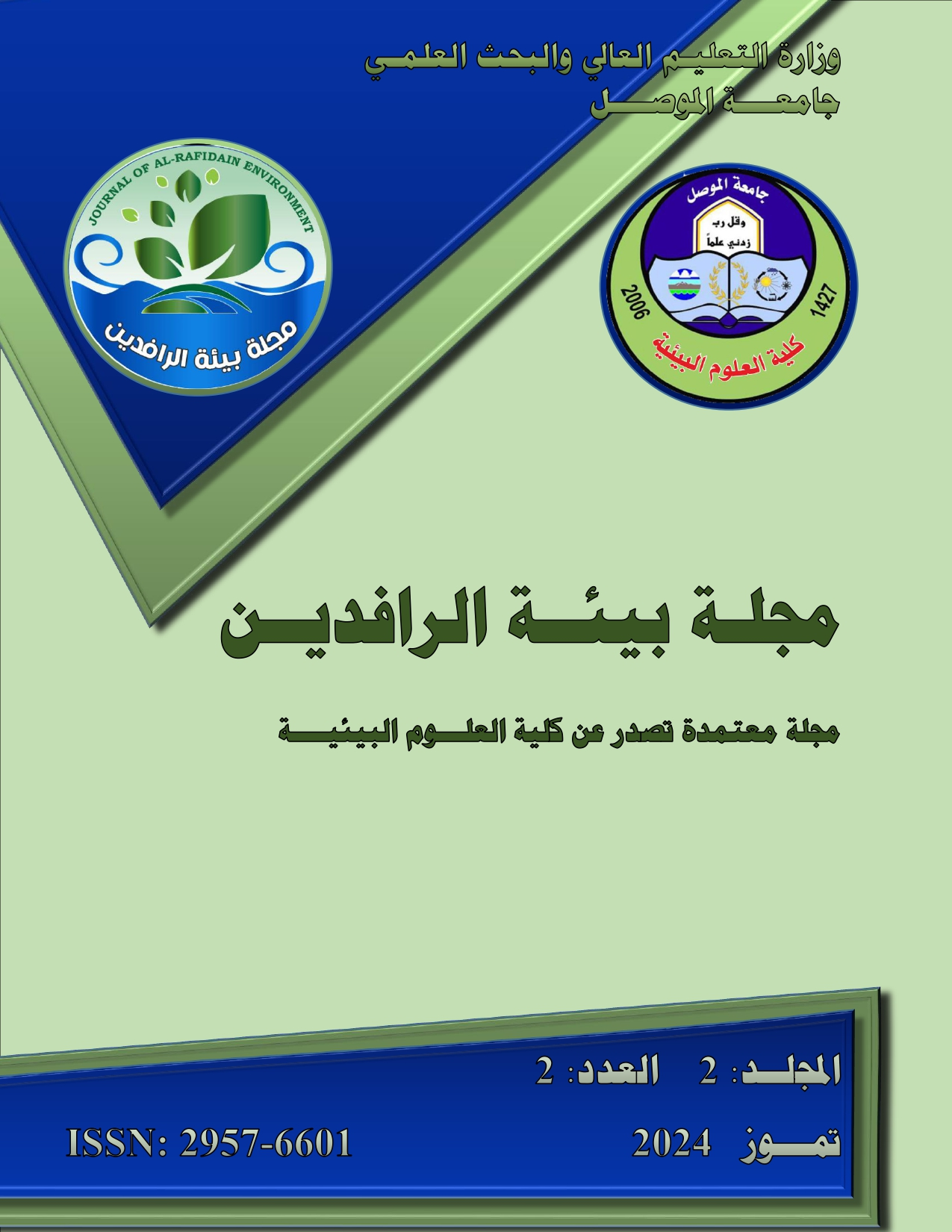تقييم نوعية المياه في بعض حمامات السباحة في مدينة الموصل / العراق

منشور
Oct 6, 2025##editor.issues.pages##
68-75الملخص
أثيرت مخاوف بشأن الآثار السلبية المحتملة على صحة الإنسان عند التعرض لمطهرات المياه المستخدمة في حمامات السباحة. من بين خيارات التطهير، تم تفضيل الكلور كمطهر أساسي في مسابح مدينة الموصل لرخص ثمنة وقدرة الكلور على التفاعل بسهولة مع المواد العضوية التي يخلفها رواد المسابح، مؤديا إلى تكوينها منتجات الكلور الثانوية التي يحتمل أن تكون ضارة (CBPs) Chlorination by-products ومصدر قلق على صحة السباحين، كلما زاد تركيز منتجات الكلور الثانوية (CBPs) في الماء، كلما زاد تركيزها في حوض السباحة، واختلاف طرق التعرض لها في حمامات السباحة (ابتلاع الماء وامتصاص الجلد والاستنشاق) إذ يؤثر على صحة السباحين الذين يبقون في الداخل لفترات طويلة، مثل مدربي السباحة، وموظفي حمامات السباحة، والسباحين التنافسيين، هدف البحث حول تقييم عن نوعية المياه في المسابح وتاثيرها على كفائة الكلور المستخدم فيها كمطهر،تم قياس تراكيز كل من الدالة الحامضية والكلور الحر والكلور الكلي والكلور المدمج خلال الفترة الصباحية والظهيرة والمسائية في6 من مسابح مدينة الموصل وكانت معدلاتهاpH6.98, 0.169 ppm, 0.327 ppm, 0.158 ppmعلى التوالي. وكانت اعلى النتائج كانت في الفترة المسائية حيث بلغت الدالة الحامضية والكلور الحر والكلور الكلي والكلور المدمج6.35 pH ,0.22 ppm, 0.43 ppm,0.21 ppm على التوالي واقلها في الفترة الصباحية وهذا دليل على ان اعداد رواد المسابح له تاثير على القيم المدروسة. نستنتج مما تقدم ان للدالة الحامضية لها تأثير مباشر ومهم على فعالية الكلور وعمله كمطهر في حمامات المسابح من حيث القضاء على الملوثات والامراض التي يحملها السباحين والرواد المصابين بها الى المسابح ثم الى الأشخاص الغير مصابين ومنع تفشي الامراض ليكون المسبح بيئة امنة لروادها.
المراجع
- Geiger, K.R. and Henschke, N., 2015. Swimming for children and adolescents with asthma. British Journal of Sports Medicine, 49(12), pp.835-836.
- Xiao, R., Ou, T., Ding, S., Fang, C., Xu, Z. and Chu, W., 2023. Disinfection by-products as environmental contaminants of emerging concern: a review on their occurrence, fate and removal in the urban water cycle. Critical Reviews in Environmental Science and Technology, 53(1), pp.19-46.
- Agache, I., Miller, R., Gern, J.E., Hellings, P.W., Jutel, M., Muraro, A., Phipatanakul, W., Quirce, S. and Peden, D., 2019. Emerging concepts and challenges in implementing the exposome paradigm in allergic diseases and asthma: a Practall document. Allergy, 74(3), pp.449-463.
- Elmas, S., Pospisilova, A., Sekulska, A.A., Vasilev, V., Nann, T., Thornton, S. and Priest, C., 2020. Photometric sensing of active chlorine, total chlorine, and pH on a microfluidic chip for online swimming pool monitoring. Sensors, 20(11), p.3099.
- Bhattacharyya, N., Tang, M., Blomdahl, D.C., Jahn, L.G., Abue, P., Allen, D.T., Corsi, R.L., Novoselac, A., Misztal, P.K. and Hildebrandt Ruiz, L., 2023. Bleach emissions interact substantially with surgical and KN95 mask Surfaces. Environmental Science & Technology, 57(16), pp.6589-6598.
- Gérardin, F., Cloteaux, A. and Midoux, N., 2015. Modeling of variations in nitrogen trichloride concentration over time in swimming pool water. Process Safety and Environmental Protection, 94, pp.452-462.
- Bernard, A., Carbonnelle, S., Dumont, X. and Nickmilder, M., 2007. Infant swimming practice, pulmonary epithelium integrity, and the risk of allergic and respiratory diseases later in childhood. Pediatrics, 119(6), pp.1095-1103.
- Florentin, A., Hautemanière, A. and Hartemann, P., 2011. Health effects of disinfection by-products in chlorinated swimming pools. International journal of hygiene and environmental health, 214(6), pp.461-469.
- Afifi, M.Z. and Blatchley III, E.R., 2015. Seasonal dynamics of water and air chemistry in an indoor chlorinated swimming pool. Water Research, 68, pp.771-783.
- Dyck R, Sadiq R, Rodriguez MJ, Simard S, Tardif R. Trihalomethane exposures in indoor swimming pools: a level III fugacity model. Water Res 2011;45:5084-98.
- Zwiener, C., Richardson, S.D., DeMarini, D.M., Grummt, T., Glauner, T. and Frimmel, F.H., 2008. Drowning in disinfection byproducts? Assessing swimming pool water. Environmental Science & Technology, 42(5), pp.1812-1812.
- Bhattacharyya, N., Tang, M., Blomdahl, D.C., Jahn, L.G., Abue, P., Allen, D.T., Corsi, R.L., Novoselac, A., Misztal, P.K. and Hildebrandt Ruiz, L., 2023. Bleach emissions interact substantially with surgical and KN95 mask Surfaces. Environmental Science & Technology, 57(16), pp.6589-6598.
- Shim, J.S., Lee, H.S., Park, D.E., Won Lee, J., Bae, B., Chang, Y., Kim, J., Kim, H.Y. and Kang, H.R., 2020. Aggravation of asthmatic inflammation by chlorine exposure via innate lymphoid cells and CD11cintermediate macrophages. Allergy, 75(2), pp.381-391.
- Kurowski, M., Jurczyk, J., Olszewska-Ziąber, A., Jarzębska, M., Krysztofiak, H. and Kowalski, M.L., 2018. A similar pro/anti-inflammatory cytokine balance is present in the airways of competitive athletes and non-exercising asthmatics. Advances in medical sciences, 63(1), pp.79-86.
تنزيل هذا الملف
الإحصائيات
##submission.copyrightAndLicensing##

هذا العمل مرخص بموجب Creative Commons Attribution-NonCommercial 4.0 International License.